Table of Contents [show]
Aspire Cleito Sub-Ohm Tank Review
Think Cleito is kind of a weird name for a tank? You’re not alone. However, the name has its origin, and you’ll have to admit that Aspire, the company that bought you the Atlantis tank, was being clever with the Cleito name.
Cleito was a mortal woman who married into a royal family of Poseidon, in Atlantis, the mythical land said to exist thousands of years ago (and probably did).
The Sub-Ohm Cleito by Aspire
The Aspire Cleito sub-ohm tank is being called state-of-the-art, cutting edge, and more, but is it? Just because something is radically different it doesn’t make it better. So rather than jump on the bandwagon with all the other vapers that have fallen for this drastically different sub-ohm tank, I decided to put it through some very tough exercises to determine if the Aspire Cleito is more hype than heroic, if the claims are hyperbole or warrant the accolades bandied about since its release.
The Aspire Cleito has, on the outside, a very minimalist appearance. Lots of glass, very little in the way of stainless steel, and a short, wide-bore mouthpiece. From all outward appearances no one would suspect the power that lies within. The humble exterior does a good job of hiding any revolutionary workings that may lie inside.
While there are new variations on the old mechanics of sub-ohm tanks on the market now as well as on the immediate horizon, the Aspire Cleito as well as the Joyetech Cubis are finally offering something truly revolutionary, with performance to match. While the Cleito and the Cubis have different aspirations, both have taken a brave step, and both have won the day.
The Aspire Cleito Body
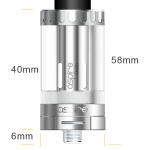 The Cleito is a top-fill tank… in that when you fill the tank you must remove the entire top-cap, whereas other top-fill tanks feature covered fill slots. The Cleito is a ‘reverse throwback’… by that I mean that before top-fill tanks we all unscrewed the bottom cap to fill, the Cleito turns that method on its head. Filling the tanks by unscrewing the top cap to fill does qualify as a top fill tank, but in very basic terms. As it turns out, this is much better approach in both the Cleito and the Cubis tanks, both of which require the removal of the top cap.
The Cleito is a top-fill tank… in that when you fill the tank you must remove the entire top-cap, whereas other top-fill tanks feature covered fill slots. The Cleito is a ‘reverse throwback’… by that I mean that before top-fill tanks we all unscrewed the bottom cap to fill, the Cleito turns that method on its head. Filling the tanks by unscrewing the top cap to fill does qualify as a top fill tank, but in very basic terms. As it turns out, this is much better approach in both the Cleito and the Cubis tanks, both of which require the removal of the top cap.
The body of the Aspire Cleito Tank is constructed with 304 stainless steel and glass. 304 Stainless Steel is what we use to make things like kitchen appliances. It’s an alloy that consists of stainless steel, nickel, and chromium. This alloy makes the Cleito lightweight, strong, durable, and resistant to corrosion. Most high-end tanks today are made with 304 SS.
The tank portion of the Cleito is made of glass. Aspire, and seemingly every other tank manufacturer like to bandy about the name “Pyrex Glass”, but Pyrex is a brand, not a form of glass, and if these tanks used actual Pyrex the Pyrex logo would appear somewhere on the tank, but it doesn’t, so I doubt that Pyrex is the glass here. Nor does it need to be Pyrex to be a good glass tank.
The Aspire Cleito can be fully disassembled for cleaning. However, the glass tank and the bottom end cap are held airtight by the use of a low opacity rubber gasket and disassembling the tank can affect its longevity.
For the most part the gasket does a good job, but there is the strong possibility that after dissembling the tank and putting it back together that same gasket might not align perfectly, and the end result could cause it to bulge, like a ruptured disk along the spine of your back. It doesn’t leak with this bulge, at least not right away, but it might not bode well for longevity of the gasket. I’ll need more time to determine the effect of this bulge. I should also mention that the 3 Cleito’s that I own, only one bulged after reassembly, so it won’t happen to every tank.
Radical Coil Head
What makes the Aspire Cleito sub-ohm tank different from the pack is the atomizer coils. To date, tanks are built with a fixed chimney that connects to a separate coil head. Aspire has reconsidered this idea, and has invented a new way to approach the necessity of this type of chimney.
The Cleito Tank’s coil head and chimney is a single piece. When the coil head expires you toss this coil head/chimney 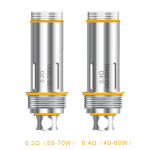 away and install a new one. You have to admit, it’s original.
away and install a new one. You have to admit, it’s original.
This new one-piece coil/chimney cause a direct connection between the drip tip and the coil. Aspire claims that this direct connection brings out maximum flavor notes, making the Cleito one of the best, if not the best, sub-ohm tank for “flavor”. I’ll discuss the truth of this claim a bit later, but consider why this one-piece set up would have any affect on flavor, and you might wonder.
The Cleito coil heads have three large e-juice flow slots that feed a constant flow of e-liquid to the Japanese organic cotton wicks. Since organic cotton absorbs large amounts of e-liquid, the more direct exposure to the eliquid in the tank, the less chance the cotton will dry out during a vape. In this respect, the large flow holes will do a good job keeping the coils saturated.
Below the aforementioned eliquid flow holes are the Cleito tank’s four airflow slots that circulate the air-intake beneath the coils, then up, over, and through the mouthpiece. Having the air flow under the coils allows the vaper to send more power to the coils without feeling the heat. The several ‘Cleito Cuffs’ that come with the tank are decorative, and functional. When used it helps dissipate the heat generated by the coils.
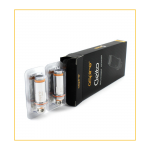 The Aspire Cleito coils are all Kanthal A-1 wire coils wrapped in a Clapton formation. A Clapton coil, two wires wrapped together, does aid in the amount of flavor and vapor production because of the large surface area the Clapton wrap creates. There are small pockets along the length of the coil that act like small e-liquid reservoirs. The Clapton build is becoming a very popular build because of these features.
The Aspire Cleito coils are all Kanthal A-1 wire coils wrapped in a Clapton formation. A Clapton coil, two wires wrapped together, does aid in the amount of flavor and vapor production because of the large surface area the Clapton wrap creates. There are small pockets along the length of the coil that act like small e-liquid reservoirs. The Clapton build is becoming a very popular build because of these features.
The base of the Cleito features dual-airflow adjustment valves, giving you the ability to fine-tune the amount of air that will be drawn into the tank while taking a hit.
Innovative or just Different?
Like many other people I too was impressed with the radical changes in the sub-ohm tank category with the Cleito and Cubis tanks. I believe we are entering into a period of revolutionary changes bought on by the the result of a few years of evolutionary changes. By the end of 2016 I suspect the technology of sub-ohm tanks will be more radical still.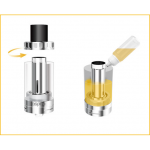
In many ways the with the Cleito, as well as the Joyetech Cubis, these changes to the fundamental elements of the sub-ohm tank are impressive. Filling tanks have never been easier, or faster, with the Cleito. The “fill and run” method is a welcome change to slow, careful, drip by drip filling methods of some of the more complicated sub-ohm tanks.
Any sub-ohm tank that gives you a wide area of glass to monitor the amount of eliquid left in the tank is also a welcome design feature. Both the Cleito and Cubis give us all the best way of making sure there is enough ‘gas in the tank’ to get us where we’re going.
Performance
The Aspire Cleito is not for everybody. This tank is a lung-hit machine, and then only beneficial to the serious hobbyist.
Where The Magic Always Lies
Fundamental design changes are fine and dandy, and if these changes add up to a better tank, then I’m all for it. But, as we all should know, half of the performance of any sub-ohm tank is the effectiveness of the coil head. The better the coil head, the better the vape is going to be.
 When a tank is designed to take advantage of the coil head, well then, you’ve got something special. So, it begs the question; how does the Cleito accomplish all it does in such a minimalist tank?
When a tank is designed to take advantage of the coil head, well then, you’ve got something special. So, it begs the question; how does the Cleito accomplish all it does in such a minimalist tank?
First, the Cleito’s Clapton build is really good. Aspire uses Kanthal A-1 wire, a small gauge wire like 22 or 24 gauge, that is then completely wrapped all the way down by a larger gauge Kanthal A-1 wire, say 30 or 32 gauge. This twisted wire allows for small pockets along the length of the coil for e-juice to rest along that coil. These pockets of ejuice along the coil will do two things; allow for a lot more surface area (wire surface and cotton surface) and more vaporizing of the eliquid, resulting in a vape experience of maximum flavor and a lot of vapor.
When the Clapton coil build become an overnight sensation there was talk of it being a fad, or not really that big of a deal, but as time as passed the Clapton is still a wonderful build, and in my experience with Tom’s Clapton coils he’s built for me and Kiera, I would say that Clapton coils last somewhat longer than standard coil builds. The nice thing about the coil heads Aspire has built for the Cleito is that no matter what Ohms the coil head is, it’s still a Clapton build. The Cleito comes with a 0.2-ohm and a 0.4-ohm coil head/chimney. The 0.4-ohm is preinstalled.
So, the fact that Aspire has chosen this Clapton build for the Cleito line is a major factor in the performance.
Another factor, just as important, is the amount of air the Cleito can pull in from the dual-airflow slots. The amount of air a tank can pull in, and where that air enters the tank, is responsible for the amount of power (wattage) the coil can handle before scorching the cotton. It’s a simple enough equation of logic that allows some 0.4-ohm coil heads to handle 30-watts and other 0.4-ohm coils to handle 65-watts.
Air + Entrance Location + Coil Build + VG % = Wattage Limits
What this boils down to is that a two-wire Clapton Kanthal A-1 wire (high quality wire) that provides more surface area for eliquid when combined with the surface area of pure organic cotton, and large amounts of air is pulled through the tank to cool the coils, aided by a wide-bore drip tip and a strong lung hit, together with plenty of wattage amounts to massive clouds of thick vapor. Each of the tiny flavor molecules are then bound to each vapor molecule. And it’s the purity of the cotton along with instant vaporization of the eliquid by the above scenario that gives an excellent sub-ohm tank the ability to pull every flavor note of the eliquid.
So Why Isn’t the Cleito Tank for Everyone?
Well, for one thing the wide-bore, short mouthpiece is not a great idea for all-day-vaping. To get the performance out of the Cleito you’re looking at strong lung hits through a wide drip tip every time. After a few hours of this type of vaping you won’t only go through lots of eliquid, it’s tiring to use strong lung hits throughout the day. In that respect, the Cleito is a lousy candidate for every day, all day use.
A tank like the Cleito requires lots of battery power, which will drain batteries quickly, and it requires a steady flow of 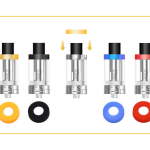 eliquid. That means having replacement batteries fully charged and at the ready, and plenty of eliquid in reserve. Because eliquid is not cheap (not the good stuff anyway) the amount of money spent on eliquid will go up.
eliquid. That means having replacement batteries fully charged and at the ready, and plenty of eliquid in reserve. Because eliquid is not cheap (not the good stuff anyway) the amount of money spent on eliquid will go up.
Having said all that, the Aspire Cleito makes for a very good RDA-like vape experience, and it could very well compete against RDA’s in cloud competitions. It might not win with expensive and tricked out RDA’s, but its not slouch either.
At $21.99 the Aspire Cleito is a modestly priced super tank. Vapor Hobbyists should have one, at least, in their tank collection when a mean-vape is looming large. As an all-day, every-day sub-ohm tank, the better solution would be the Joyetech Cubis.
To put it simply; the Aspire Cleito gives jaw-dropping performance.
Recommendations?
Despite its harmless looking appearance the Aspire Cleito is a serious performer. It is also a Lung-Hit only tank, mouth-to-lung vapers need not apply. Just because the Cleito carries the Aspire name, don’t for a minute mistake it for a mild-mannered Subtank Mini.
If you are the type of vaper that is “all in”, and you’re looking for better, thicker, tastier vape experiences all the time than you owe it to yourself to pick one up. The battery power and the eliquid consumption means you’ll pay for the experience, but the return on that investment is a whole hell of a lot of flavor and vapor.
As I was about to finish up this review I was informed of a new RTA coming for the Aspire Cleito. I will make every attempt to bring you a review of the RTA as soon as possible.
Buy this powerful tank Here:
Julia Hartley-Barnes (with Tom McBride)





